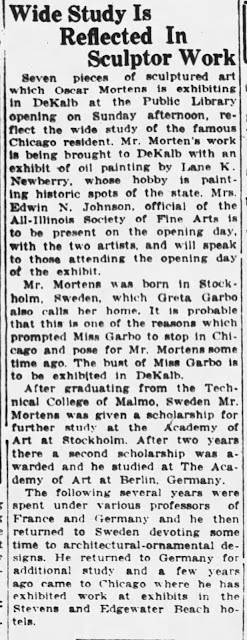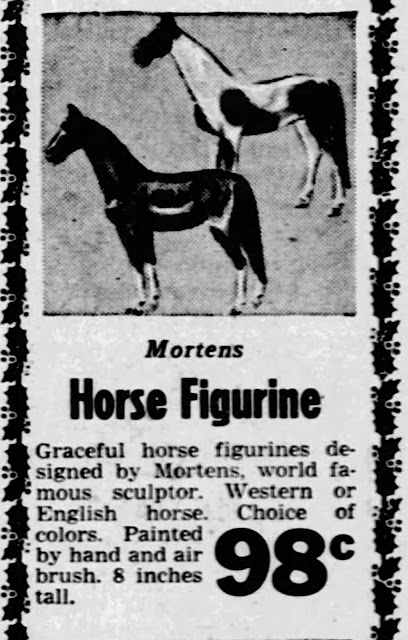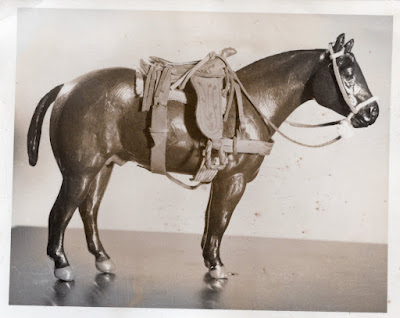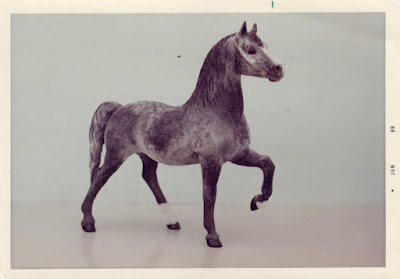This Mortens Studio Pinto was owned, for much of its life, by an Illinois horse lover whose first initial was F. She collected model horses for much of her life. Many of the horses F. owned pre-date what we consider the "organized" model horse hobby, which began to take shape in the late 1960s.
This fellow dates to at least the mid-1940s, if not earlier.
When F. passed away about 40 years ago, the Pinto and her other model horses went to her family, and over the weekend they were kind enough to sell me her collection.
The Pinto looks happy. And he should be, because a) he was loved; and b) he's a survivor. It is difficult to find a Mortens Studio animal, with its heavy metal frame under a ceramic and plaster body that has been painted and glazed, in such great condition. In short -- the finish cracks and chips very easily.
Mortens Studio horses are not in great demand by 21st century collectors, but they do have their fans, who are charmed by their personalities and their history.
F. put tiny stickers on many of her horse figurines, and wrote down who had given them to her. She noted that horse was given to her by one of her children, and that it was "one of my favorites." This horse was dearly loved and cherished, and now he seems happy to be here.
We see the Mortens Studio Pinto horse in Sears Christmas ads in the Upper Midwest and the South, dating from 1945. World War II was over, the soldiers were home or nearly home, and it was time to decorate the house with something meaningful. The Pinto and another horse are identified as "Western Style" and "English Style," perhaps referring to the colors.
You can see that his spot pattern is similar to the horse in the ad. Variations are common in hand-painted figurines.
 |
___________________________________________
A bit of background on Mortens Studio:
It's common to see such horse figurines referred to as being by "Morten Studio" or "Morten's Studio," but the correct spelling of their creator's last name is Mortens, with an S at the end.
Oscar Wilhelm Mortenson (1878-1962) only created animal figurines for a few decades, and not much is known about his company. Born in Skahult, Sweden, Mortens studied at the Academy of Fine Arts in Stockholm and the Berlin Academy of Art. He came to the US in 1923.
 |
| Source: US Federal Naturalization Records, via Ancestry.com |
We see him living in Illinois and taking part in art exhibitions in the early 1930s, and applying for US citizenship in 1935. He had his name legally changed to Oscar Mortens in 1940. Newspaper articles call him a "well-known Chicago sculptor."
 |
| DeKalb, IL Daily Chronicle, 1 December 1932 |
Some accounts say that Mortens started his ceramics business in 1931. The first newspaper ads I see for Mortens Studio horses are from 1943. By the mid-1950s, Mortens was selling not only horse figurines but also horse head plaques. They were marketed as ornaments and paperweights. Like other horse figurines of that era, the prospective buyer was seen as a man, rather than a woman or child. These Mortens Studio horse plaques were "for Dad's den or office."
Many hobbyists believe that most Mortens Studio dogs, cats, and livestock are more realistic than the company's horse figurines.
 |
| Mortens Studio English Setter puppies. Each bears a sticker that says, "I am an English Setter." |
 |
| Mortens Studio Persian cat. |
 |
| Decatur, IL Herald and Review, 11 December 1955 |
 |
| Mortens Studio cow, as seen at an antique mall. |
In 1942, Oscar Mortens and his wife, psychiatrist Dr. Selma Colbe Mortens, bought property near Santa Cruz, California. In 1947, the couple moved to Phoenix, Arizona for his health. The 19 October 1952 Arizona Republic ran the following article on them. Mortens told the Republic that he wanted to mass-produce ceramics because commissions for sculptures were few and far between. Mortens started out creating plaques of famous Hollywood celebrities, but the only one that sold well was of humorist Will Rogers; the University of Oklahoma bought them for its students.
Mortens said, "Then I tried animals, horses first, then dogs and other animals. They caught on immediately. Now we have a factory in Chicago, and I spend a great deal of time back there."
Oscar Mortens died in Phoenix in September 1962, and is buried in Chicago.
_________________________________________________
Here's a link summarizing Mortens' career, with photos of some of his work:














.JPG)

.JPG)














a.jpg)
b.jpg)




.jpg)














































.jpg)












